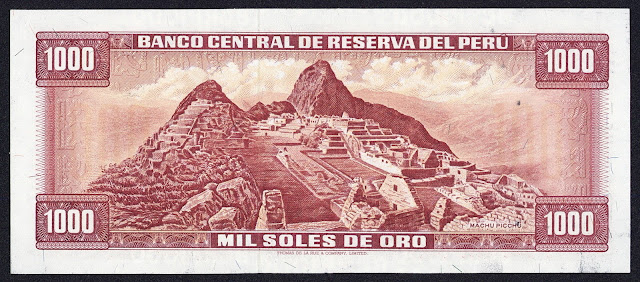Peru Banknotes 1000 Soles de Oro banknote 1975
Central Reserve Bank of Peru - Banco Central de Reserva del Perú
Obverse: Portraits of Miguel Grau & Francisco Bolognesi, Coat of arms of Peru at center. In each corner, the denomination value "1000" within a guilloche.
Reverse: Panoramic view of Machu Picchu at center. In each corner, the denomination value "1000" within a guilloche.
Printer: Thomas De La Rue & Company Limited, London, England.
Peru Banknotes - Peruvian Paper Money
1968-1975
5 Soles de Oro 10 Soles de Oro 50 Soles de Oro 100 Soles de Oro
200 Soles de Oro 500 Soles de Oro 1000 Soles de Oro
200 Soles de Oro 500 Soles de Oro 1000 Soles de Oro
Machu Picchu
Machu Picchu (in hispanicized spelling, Spanish pronunciation: or Machu Pikchu (Quechua machu old, old person, pikchu peak; mountain or prominence with a broad base which ends in sharp peaks, "old peak", is a 15th-century Inca site located 2,430 metres (7,970 ft) above sea level. It is located in the Cusco Region, Urubamba Province, Machupicchu District in Peru. It is situated on a mountain ridge above the Sacred Valley which is 80 kilometres (50 mi) northwest of Cuzco and through which the Urubamba River flows. Most archaeologists believe that Machu Picchu was built as an estate for the Inca emperor Pachacuti (1438 – 1472). Often mistakenly referred to as the "Lost City of the Incas", it is the most familiar icon of Inca civilization.
The Incas built the estate around 1450, but abandoned it a century later at the time of the Spanish Conquest. Although known locally, it was not known to the Spanish during the colonial period and remained unknown to the outside world before being brought to international attention in 1911 by the American historian Hiram Bingham. Since then, Machu Picchu has become the largest tourist attraction in South America.[citation needed] Most of the outlying buildings have been reconstructed in order to give tourists a better idea of what the structures originally looked like. By 1976, thirty percent of Machu Picchu had been restored. The restoration work continues to this day.
Machu Picchu was declared a Peruvian Historical Sanctuary in 1981 and a UNESCO World Heritage Site in 1983. In 2007, Machu Picchu was voted one of the New Seven Wonders of the World in a worldwide Internet poll.
Machu Picchu was built in the classical Inca style, with polished dry-stone walls. Its three primary structures are the Inti Watana, the Temple of the Sun, and the Room of the Three Windows. These are located in what is known by archaeologists as the Sacred District of Machu Picchu.
Machu Picchu is vulnerable to threats. While natural phenomena like earthquakes and weather systems can play havoc with access, the site also suffers from the pressures of too many tourists. In addition, preservation of the area's cultural and archaeological heritage is an ongoing concern.

